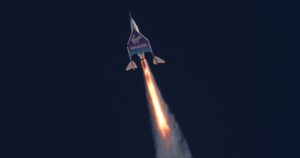Virgin Galactic launched its first commercial spaceflight — dubbed Galactic 01 — on Thursday, five weeks after passing its final test. A three-person crew from Italy joined three Virgin Galactic crew members aboard the VSS Unity for a suborbital journey to the edge of space, where they conducted microgravity research. Virgin Galactic has now joined Elon Musk’s SpaceX and Jeff Bezos’ Blue Origin in taking paying customers to space. It already has an 800-customer waitlist, and it’s raising funding for a fleet, with each aircraft flying at least once a week, according to CNBC.
By Melissa Cantor, Editor at LinkedIn News
Virgin Galactic launches third successful spaceflight
Virgin Galactic’s rocket-powered plane, carrying two pilots, soared into the upper atmosphere on its third mission to reach space Saturday morning.
The success cues up Virgin Galactic to begin launching paying customers within the next year as the company works to finish its testing campaign at its new headquarters in New Mexico.
Spaceplane VSS Unity reached an altitude of 55.45 miles, according to the company. The US government recognizes the 50-mile mark as the edge of space. The company tweeted Saturday morning that the spaceflight carried technology experiments for NASA’s Flight Opportunities Program.
Saturday’s flight comes after Virgin Galactic’s last spaceflight attempt ended abruptly when the rocket engine that powers the space plane, called VSS Unity, failed to ignite, setting the company’s testing schedule back by months.

Virgin Galactic, founded by British billionaire Richard Branson in 2004, has spent years pledging to take groups of customers on brief, scenic flights to suborbital space. But the company has faced a series of complications and delays, including a 2014 test flight crash that left one pilot dead.
Nonetheless, Virgin Galactic has already sold tickets for $200,000 to $250,000 to more than 600 people. And the company said it expects to see broad interest when ticket sales reopen – tickets that will be sold at a higher price than previously.
Recently, the company installed a new CEO, former Disney executive Michael Colglazier, and has been pledging to slowly ramp up to commercial operations over the next year or so. It’s also focused on constructing a new line of planes, called SpaceShipIII, and is angling to one day fly about 400 flights each year from its New Mexico spaceport.
By , CNN Business











